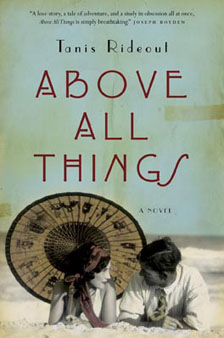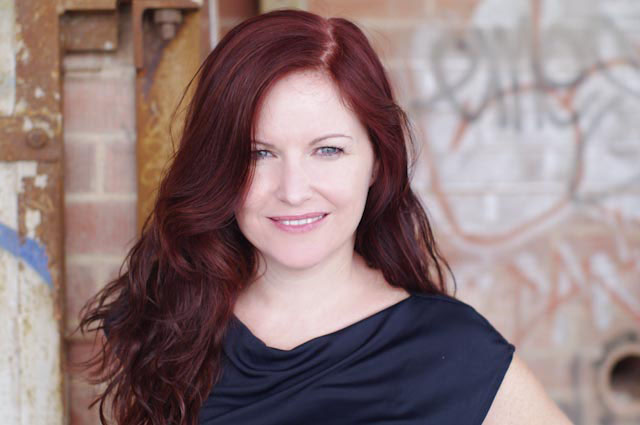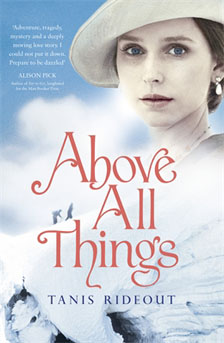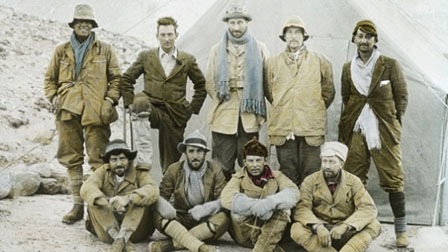Tanis Rideout: Striking for the summit
by Mark ReynoldsTanis Rideout’s debut novel Above All Things is a tense and seductive blend of historical fact and speculative fiction that weaves together the story of George Mallory’s ill-fated 1924 attempt to conquer Everest with that of a single day in the life of his wife Ruth as she waits at home for news of his return. Mark Reynolds fires off some questions about recreating events that are quite deeply ingrained in the popular imagination.
MR: What drew you to the story of Mallory and Ruth, and how did the novel take shape?
TR: I became particularly fascinated by George some years ago when I worked at an outdoor equipment store and watched a video with some of the early Everest footage – the whole of it just swept me up and I began to read everything I could get my hands on. George was such a compelling, charismatic character – an athlete, a writer, a thinker who hung around with some of the Bloomsbury set – and tremendously good looking to boot. I couldn’t shake him, so I began to write about him. I always knew, though, that Ruth would be a big part of the story. Women’s stories are important to me – I wanted to know who she would be – this woman married to this extraordinary man, she had to be extraordinary in her own right, surely. I think at one point I thought of writing the entire novel from her point of view, but that quickly became very limiting. It seemed to me Ruth would give us quite a different view of George than we might get otherwise, and so the dual storyline began to take shape and was reshaped over and over again as the process went on.
The physical shape and feel of letters and notebooks and photographs provided a vast amount of colour for the book – it allowed the era and the characters to come alive.”
MR: How long was the writing process?
TR: I think I worked out that I finished the first draft about seven years ago. There were several long gaps between drafts as I worked on other things – including a poetry collection published here in Canada in April. It did take a long time, lots of waiting and thinking between drafts. I’m hopeful that I’ve become more efficient and the next one won’t take as long!
MR: Did you visit the Himalayas as part of your research? So what is the closest you’ve been to the summit of Everest?
TR: No! I’ve never been to that part of the world, though I would love too. I think someday – hopefully sooner rather than later, I’ll do the trek to Base Camp, but I wouldn’t even contemplate trying to climb it. I certainly didn’t climb at all when I started writing the book. Since then I’ve done some indoor climbing and a couple of non-technical climbs. The closest I’ve been – the highest I’ve been – was this past January. My husband and I climbed Mauna Loa in Hawaii. We didn’t quite make the summit – I turned us back – but made it almost the full 13,679 feet – certainly not Everest which is over 29,000 feet.
MR: What other fiction have you written, and how much of it has been historical?
TR: I love historical fiction – I studied history for a while at university. I have a terrible novel in a drawer that will never see the light of day. It’s historical and loosely based on my grandparents’ life together during and after the Second World War. My poetry collection could also be considered ‘historical fiction’. It’s based on Marilyn Bell’s swim across Lake Ontario in the 1950s.
MR: What were the unique challenges of bringing this story to the page?
TR: I think one of the biggest challenges with Above All Things was balancing George and Ruth’s stories. On the one hand you have the inherently exciting epic of trying to climb a mountain – THE mountain. The sheer scale of that story is immense – it covers a great deal of time and terrain, there’s a wide array of characters. On the other hand there’s Ruth’s very intimate, ‘small’ story – which covers a very small time frame in a very limited location. The two stories had to be able to stand up next to each other, they had to have matching emotional weight and heft. That took a great deal of work and shaping. For the most part the two stories were worked almost entirely separately so that they would hold together on their own and then put back together and interconnected as we moved further through the process.
MR: What are the hazards in trying to replicate the speech patterns and social etiquette of 1920s Britain?
TR: I think they’re probably the same as trying to create the speech patterns and etiquette of almost any place or time. As a writer I want to create a world that both the characters and the reader can believe in and inhabit. In order to do that, I think, it’s not about overwhelming detail, but about trying to find the right detail. Sometimes, I think that right detail might not even necessarily be historically factual, but if it helps conjure the time and place for a reader, then I think it can be right, if that makes sense. We already have a sensibility for other eras from all the other books, movies, TV we’ve taken in – that can sometimes be really useful, sometimes very disruptive. People in books never really talk like real people. Not even when they’re set today. They talk in a way that makes us believe they’re real people. There’s a fine balance to that I think – striking a tone that is authentic but doesn’t alienate a reader. It’s a bit of writerly sleight of hand, when it’s done well.
MR: How much of a thrill was it to be able to handle and read George and Ruth’s private letters, and what did such artefacts bring to your storytelling?
TR: It was pretty emotional to actually be able to hold documents, letters, telegrams and such that George and Ruth, and others of my characters had held. A very odd feeling – part intrusive, part thrill, part awe. By the time I was able to visit England and do that kind of research I’d already been living with George and Ruth in my head for some time, so it really was pretty astounding to have these tangible connections to them. What I find interesting is that actually being able to handle those letters and such, really freed me up to write and imagine the characters and the world in some ways. It allowed me to jump even more into the fictional – the documents became a springboard to leap off from. The plethora of detail in those papers – the language, and also the physical shape and feel of letters and notebooks and photographs provided a vast amount of colour for the book – it allowed the era and the characters, I hope, to come alive.
MR: Why did you decide to use dramatic licence to transfer Trafford Mallory’s death to the First World War, and Maurice Wilson’s attempt at the summit from 1932 to before Mallory’s climbs?
TR: I decided fairly early on that I didn’t feel the need to hold fast to the historical record – there are so many fantastic non-fiction works out there about George Mallory, Sandy Irvine, those early Everest expeditions. Certainly the world didn’t need that from me. On the factual front, I’m not sure that I could add anything to it. What I was interested in doing was delving into character and relationships – I wanted to get to an emotional truth, I think, rather than a factual truth. Who were these people – these kinds of people, types of people? What kind of man goes three times to try and climb Everest? Trafford’s death became, in a sense, a kind of shorthand for the pain and grief, guilt and responsibility, that I think each of the men on the expedition must have been dealing with after the First World War. Trafford became a symbol of all of that – and a way to get the reader to feel those things in a way that I don’t think would have had the same resonance if it was a friend or cousin or some such. And the Wilson story is so incredible, and such an indicator of the kind of allure and pull that Everest had and continues to have. I think the story helps to give shape to that obsessive pull in a way that smaller stories and details, though they may have been historically accurate, might not.
MR: How did you feel when you learned that “the world’s greatest storyteller” Jeffrey Archer was writing his own Mallory novel? Did you read it? If so, how does his approach to the story differ from your own – for example, in his depiction of Ruth?
TR: I will admit I wondered if it would affect my chances of getting my book published! But I also wasn’t hugely surprised. It’s such a fantastic story that I was a bit stunned it took as long as it did for someone to write it. (There is a Canadian book called Deathful Ridge which is also about Mallory, but a very fantastical, beautiful take). I have only read parts of Archer’s story – I slipped in and out of it a few times while I was writing – so I can’t really comment on it. Perhaps now that my own version of George and Ruth is starting to be farther behind me I can pick up both Archer’s book and Wade Davis’s Into the Silence.
MR: Mallory’s final climb was the subject of the documentary The Wildest Dream, which was informed by Conrad Anker’s 1999 discovery of Mallory’s body (and in which Ruth is eerily voiced by Natasha Richardson in her final role). Are there any plans to bring Above All Things to the screen – and is there room for another Everest movie?
TR: I would, of course, love to see a film version of Above All Things, but there are no plans at the moment. I did just recently imagine my own cast and crew for a US website, which was hugely fun – and a movie I would definitely go see! And there are rumours about Archer’s book being made, so again, as with his book, I wonder if that would affect my chances. But there are always lots of rumours in Hollywood. The Wildest Dream was tremendously gorgeous, I loved the way they put the story together – the use of the images and letters was incredibly moving. It wouldn’t surprise me in the least, to someday see a big-budget version of the 1924 expedition. In some ways, I’m surprised it hasn’t happened yet – it is such a fantastic story, such a cinematic story.
MR: The British Film Institute is currently restoring John Noel’s The Epic of Everest. Did you watch the existing version, and are you looking forward to the new release?
TR: Oh – I hadn’t heard that they were restoring it! Amazing, yes, I can’t wait to see it. I did go and see The Epic of Everest at the BFI while I was in England. It wasn’t under the best of circumstances – they’d had a sewage backup a couple of days before, and the place was still not entirely pleasant! Still, it was so fantastic to see the film in its entirety, since it was a clip from the film that had started me down this path.
MR: What has been your greatest adventure?
TR: Hmm… I think I’m mildly adventurous and aiming to be more so. I’ve started climbing a little bit – I climbed Mauna Loa and a couple of big day climbs in the Adirondacks. I scuba dive. I think the hardest physical thing I’ve done so far was climbing in the Adirondacks. Not necessarily the most adventurous thing I’ve ever done – but I was breaking in new boots, so my feet were just torn apart. I fell and hurt my wrist quite badly. It was pretty terrible – but I was quite pleased with myself when I was done it and definitely made me feel I was up to something a bit more rugged, a bit more daring. I’m kind of thinking about what to do next. Maybe a climb in Colorado…
MR: Where and when were you coldest?
TR: Living in Canada, being cold is often part of the territory and I’m almost always cold. But one time I can think of was going hiking on Toronto Island on a very very cold, windy, winter day. I wasn’t dressed properly and was out for hours on the island – there’s nowhere to hide out there in the winter – no cafes, restaurants, nothing. I was pretty miserable by the end of it waiting for the ferry home. That or camping overnight in Yosemite. Part of how cold it felt was that earlier in the day we’d be sweltering in Death Valley, so the high negative temperatures felt even more frigid. My husband and I spent the night fighting over our sleeping bags. He says I stole them all while he shivered in the cold!”

MR: Did Viking discuss with you their choice of cover for the UK edition? Might they have shifted its appeal too strongly towards women readers? I certainly miss the Art Deco typography of the Canadian edition.
TR: The process of covers is still a bit of a mystery to me – though I will admit that I too LOVE the font from the Canadian edition. It’s a Frank Lloyd Wright font – perfect for the era, I think. It’s been interesting to see how the book is interpreted for different audiences and markets – some focusing on women, some focusing on men. Generally, I try and trust that the people coming up with the designs have a sense of what works for their market, because I really don’t know! I’ve shown the different covers around to book clubs and the like when I visit with them – and people respond to them all very differently. Some love the UK cover, some the American, some the original Canadian.
MR: In 2006 you became Poet Laureate for Lake Ontario. Can you tell me a little about that, and about your wider environmental campaigning?
TR: I was named the Poet Laureate for Lake Ontario by the Lake Ontario Waterkeeper – an environmental justice organisation committed to protecting our rights to swim, drink and fish on our watershed. There’s a London Canalkeeper as well, doing the same kind of work for the Thames and London’s other waterways, and there are Waterkeepers all over the world. I came to their attention because I’d written a poem to take on tour with Sarah Harmer, a musician and friend who was working to try and stop quarrying on the Niagara Escarpment, a designated World Biosphere, which she and others successfully did just last year. When Waterkeeper asked me to join them I was thrilled. I love the water – I grew up on the water and have spent numerous years on the shores of Lake Ontario. And the idea of writing the poems was a challenge. So I jumped in, so to speak, with both feet and began to look at my own relationship with the lake in an attempt to get people to examine theirs and to recommit to making the lake ours – not just let industry and government make decisions. We need to remain part of the process. It’s stunning to me how wilfully blind and short-sighted our politicians continue to be regarding the environment and our natural resources. I’m continuing to lend my voice to Waterkeeper and other organisations where and when I can. I certainly hope the poetry collection that came out of the Waterkeeper appointment will get people to think about Lake Ontario at least a little bit.
MR: Most of the environmental news we hear about Canada in the UK concerns tar sands, fracking, Arctic drilling or the destruction of habitats. What is the good news, and is it enough to give you hope?
TR: The good news… I think the good news is that communities in Canada and across North America seem to be galvanised in the face of all the bad news, which some days feels overwhelming. It’s easy to be exhausted, it’s easy to throw your hands up and feel it’s impossible – but it’s amazing to watch communities rally and people speak out. It’s so heartening to watch the Idle No More campaign sweeping across not just Canada, but the world, or the recent climate rally in Washington DC. People really seem to be taking notice now, standing up and making themselves heard. I think ‘environmentalists’ are no longer on the fringe – everyone is aware to some extent of what’s at risk. I think people are sick and tired of being manipulated and hearing that science and process are being ignored and dismantled. They’re standing up. That gives me hope.
MR: What are you writing next?
TR: My poetry collection Arguments with the Lake just came out in Canada, so now I’m just at the very beginning of a new project. I’m reading a lot, making notes, staring into space. I think it will have two storylines. One will be set in the past, and one present day – I’m feeling a desperate desire to write something with cell phones and computers in it – the ephemera of our world. I have a feeling for it already in my head, now, it’s just trying to capture that on paper.
Above All Things is published by Viking. Read more.
Author portrait © Nikki Mills




